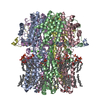+ Open data
Open data
- Basic information
Basic information
| Entry |  | ||||||||||||||||||||||||
|---|---|---|---|---|---|---|---|---|---|---|---|---|---|---|---|---|---|---|---|---|---|---|---|---|---|
| Title | BEST2 + GABA closed state | ||||||||||||||||||||||||
 Map data Map data | sharpmap | ||||||||||||||||||||||||
 Sample Sample |
| ||||||||||||||||||||||||
 Keywords Keywords | calcium-activated chloride channel / GABA-bound anion channel / channel-activator complex / membrane protein | ||||||||||||||||||||||||
| Function / homology |  Function and homology information Function and homology informationintracellularly ligand-gated monoatomic ion channel activity / ligand-gated monoatomic anion channel activity / bicarbonate channel activity / ligand-gated monoatomic cation channel activity / chloride channel activity / membrane depolarization / chloride channel complex / Stimuli-sensing channels / sensory perception of smell / basolateral plasma membrane ...intracellularly ligand-gated monoatomic ion channel activity / ligand-gated monoatomic anion channel activity / bicarbonate channel activity / ligand-gated monoatomic cation channel activity / chloride channel activity / membrane depolarization / chloride channel complex / Stimuli-sensing channels / sensory perception of smell / basolateral plasma membrane / cilium / metal ion binding / plasma membrane Similarity search - Function | ||||||||||||||||||||||||
| Biological species |  Homo sapiens (human) Homo sapiens (human) | ||||||||||||||||||||||||
| Method | single particle reconstruction / cryo EM / Resolution: 2.27 Å | ||||||||||||||||||||||||
 Authors Authors | Owji AP / Kittredge A / Zhang Y / Yang T | ||||||||||||||||||||||||
| Funding support |  United States, 7 items United States, 7 items
| ||||||||||||||||||||||||
 Citation Citation |  Journal: Nat Commun / Year: 2024 Journal: Nat Commun / Year: 2024Title: Neurotransmitter-bound bestrophin channel structures reveal small molecule drug targeting sites for disease treatment. Authors: Aaron P Owji / Jingyun Dong / Alec Kittredge / Jiali Wang / Yu Zhang / Tingting Yang /  Abstract: Best1 and Best2 are two members of the bestrophin family of anion channels critically involved in the prevention of retinal degeneration and maintenance of intraocular pressure, respectively. Here, ...Best1 and Best2 are two members of the bestrophin family of anion channels critically involved in the prevention of retinal degeneration and maintenance of intraocular pressure, respectively. Here, we solved glutamate- and γ-aminobutyric acid (GABA)-bound Best2 structures, which delineate an intracellular glutamate binding site and an extracellular GABA binding site on Best2, respectively, identified extracellular GABA as a permeable activator of Best2, and elucidated the co-regulation of Best2 by glutamate, GABA and glutamine synthetase in vivo. We further identified multiple small molecules as activators of the bestrophin channels. Extensive analyses were carried out for a potent activator, 4-aminobenzoic acid (PABA): PABA-bound Best1 and Best2 structures are solved and illustrate the same binding site as in GABA-bound Best2; PABA treatment rescues the functional deficiency of patient-derived Best1 mutations. Together, our results demonstrate the mechanism and potential of multiple small molecule candidates as clinically applicable drugs for bestrophin-associated diseases/conditions. | ||||||||||||||||||||||||
| History |
|
- Structure visualization
Structure visualization
| Supplemental images |
|---|
- Downloads & links
Downloads & links
-EMDB archive
| Map data |  emd_47307.map.gz emd_47307.map.gz | 230.4 MB |  EMDB map data format EMDB map data format | |
|---|---|---|---|---|
| Header (meta data) |  emd-47307-v30.xml emd-47307-v30.xml emd-47307.xml emd-47307.xml | 20.8 KB 20.8 KB | Display Display |  EMDB header EMDB header |
| Images |  emd_47307.png emd_47307.png | 142.8 KB | ||
| Filedesc metadata |  emd-47307.cif.gz emd-47307.cif.gz | 6.3 KB | ||
| Others |  emd_47307_additional_1.map.gz emd_47307_additional_1.map.gz emd_47307_half_map_1.map.gz emd_47307_half_map_1.map.gz emd_47307_half_map_2.map.gz emd_47307_half_map_2.map.gz | 123.1 MB 226.8 MB 226.8 MB | ||
| Archive directory |  http://ftp.pdbj.org/pub/emdb/structures/EMD-47307 http://ftp.pdbj.org/pub/emdb/structures/EMD-47307 ftp://ftp.pdbj.org/pub/emdb/structures/EMD-47307 ftp://ftp.pdbj.org/pub/emdb/structures/EMD-47307 | HTTPS FTP |
-Validation report
| Summary document |  emd_47307_validation.pdf.gz emd_47307_validation.pdf.gz | 1.1 MB | Display |  EMDB validaton report EMDB validaton report |
|---|---|---|---|---|
| Full document |  emd_47307_full_validation.pdf.gz emd_47307_full_validation.pdf.gz | 1.1 MB | Display | |
| Data in XML |  emd_47307_validation.xml.gz emd_47307_validation.xml.gz | 15.7 KB | Display | |
| Data in CIF |  emd_47307_validation.cif.gz emd_47307_validation.cif.gz | 18.6 KB | Display | |
| Arichive directory |  https://ftp.pdbj.org/pub/emdb/validation_reports/EMD-47307 https://ftp.pdbj.org/pub/emdb/validation_reports/EMD-47307 ftp://ftp.pdbj.org/pub/emdb/validation_reports/EMD-47307 ftp://ftp.pdbj.org/pub/emdb/validation_reports/EMD-47307 | HTTPS FTP |
-Related structure data
| Related structure data |  9dykMC 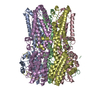 9dyhC  9dyiC 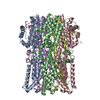 9dyjC  9dylC 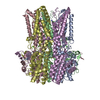 9dymC  9dynC 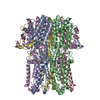 9dyoC M: atomic model generated by this map C: citing same article ( |
|---|---|
| Similar structure data | Similarity search - Function & homology  F&H Search F&H Search |
- Links
Links
| EMDB pages |  EMDB (EBI/PDBe) / EMDB (EBI/PDBe) /  EMDataResource EMDataResource |
|---|
- Map
Map
| File |  Download / File: emd_47307.map.gz / Format: CCP4 / Size: 244.1 MB / Type: IMAGE STORED AS FLOATING POINT NUMBER (4 BYTES) Download / File: emd_47307.map.gz / Format: CCP4 / Size: 244.1 MB / Type: IMAGE STORED AS FLOATING POINT NUMBER (4 BYTES) | ||||||||||||||||||||||||||||||||||||
|---|---|---|---|---|---|---|---|---|---|---|---|---|---|---|---|---|---|---|---|---|---|---|---|---|---|---|---|---|---|---|---|---|---|---|---|---|---|
| Annotation | sharpmap | ||||||||||||||||||||||||||||||||||||
| Projections & slices | Image control
Images are generated by Spider. | ||||||||||||||||||||||||||||||||||||
| Voxel size | X=Y=Z: 0.83 Å | ||||||||||||||||||||||||||||||||||||
| Density |
| ||||||||||||||||||||||||||||||||||||
| Symmetry | Space group: 1 | ||||||||||||||||||||||||||||||||||||
| Details | EMDB XML:
|
-Supplemental data
-Additional map: fullmap
| File | emd_47307_additional_1.map | ||||||||||||
|---|---|---|---|---|---|---|---|---|---|---|---|---|---|
| Annotation | fullmap | ||||||||||||
| Projections & Slices |
| ||||||||||||
| Density Histograms |
-Half map: halfA
| File | emd_47307_half_map_1.map | ||||||||||||
|---|---|---|---|---|---|---|---|---|---|---|---|---|---|
| Annotation | halfA | ||||||||||||
| Projections & Slices |
| ||||||||||||
| Density Histograms |
-Half map: halfB
| File | emd_47307_half_map_2.map | ||||||||||||
|---|---|---|---|---|---|---|---|---|---|---|---|---|---|
| Annotation | halfB | ||||||||||||
| Projections & Slices |
| ||||||||||||
| Density Histograms |
- Sample components
Sample components
-Entire : BEST2 + GABA closed state
| Entire | Name: BEST2 + GABA closed state |
|---|---|
| Components |
|
-Supramolecule #1: BEST2 + GABA closed state
| Supramolecule | Name: BEST2 + GABA closed state / type: complex / ID: 1 / Parent: 0 / Macromolecule list: #1 |
|---|---|
| Source (natural) | Organism:  Homo sapiens (human) Homo sapiens (human) |
| Molecular weight | Theoretical: 286 KDa |
-Macromolecule #1: Bestrophin-2
| Macromolecule | Name: Bestrophin-2 / type: protein_or_peptide / ID: 1 / Number of copies: 5 / Enantiomer: LEVO |
|---|---|
| Source (natural) | Organism:  Homo sapiens (human) Homo sapiens (human) |
| Molecular weight | Theoretical: 46.796898 KDa |
| Recombinant expression | Organism:  Homo sapiens (human) Homo sapiens (human) |
| Sequence | String: MTVTYTARVA NARFGGFSQL LLLWRGSIYK LLWRELLCFL GFYMALSAAY RFVLTEGQKR YFEKLVIYCD QYASLIPVSF VLGFYVTLV VNRWWSQYLC MPLPDALMCV VAGTVHGRDD RGRLYRRTLM RYAGLSAVLI LRSVSTAVFK RFPTIDHVVE A GFMTREER ...String: MTVTYTARVA NARFGGFSQL LLLWRGSIYK LLWRELLCFL GFYMALSAAY RFVLTEGQKR YFEKLVIYCD QYASLIPVSF VLGFYVTLV VNRWWSQYLC MPLPDALMCV VAGTVHGRDD RGRLYRRTLM RYAGLSAVLI LRSVSTAVFK RFPTIDHVVE A GFMTREER KKFENLNSSY NKYWVPCVWF SNLAAQARRE GRIRDNSALK LLLEELNVFR GKCGMLFHYD WISVPLVYTQ VV TIALYSY FLACLIGRQF LDPAQGYKDH DLDLCVPIFT LLQFFFYAGW LKVAEQLINP FGEDDDDFET NFLIDRNFQV SML AVDEMY DDLAVLEKDL YWDAAEARAP YTAATVFQLR QPSFQGSTFD ITLAKEDMQF QRLDGLDGPM GEAPGDFLQR LLPA GAGMV A UniProtKB: Bestrophin-2a |
-Macromolecule #2: CALCIUM ION
| Macromolecule | Name: CALCIUM ION / type: ligand / ID: 2 / Number of copies: 5 / Formula: CA |
|---|---|
| Molecular weight | Theoretical: 40.078 Da |
-Macromolecule #3: CHLORIDE ION
| Macromolecule | Name: CHLORIDE ION / type: ligand / ID: 3 / Number of copies: 1 / Formula: CL |
|---|---|
| Molecular weight | Theoretical: 35.453 Da |
-Experimental details
-Structure determination
| Method | cryo EM |
|---|---|
 Processing Processing | single particle reconstruction |
| Aggregation state | particle |
- Sample preparation
Sample preparation
| Concentration | 5 mg/mL | ||||||||||||
|---|---|---|---|---|---|---|---|---|---|---|---|---|---|
| Buffer | pH: 7.8 Component:
| ||||||||||||
| Grid | Model: UltrAuFoil R0./1 / Material: GOLD / Support film - Material: GOLD / Support film - topology: HOLEY | ||||||||||||
| Vitrification | Cryogen name: ETHANE / Chamber humidity: 100 % / Chamber temperature: 283 K / Instrument: FEI VITROBOT MARK IV |
- Electron microscopy
Electron microscopy
| Microscope | TFS KRIOS |
|---|---|
| Specialist optics | Energy filter - Slit width: 20 eV |
| Software | Name: Leginon |
| Image recording | Film or detector model: GATAN K3 (6k x 4k) / Number grids imaged: 1 / Number real images: 1130 / Average electron dose: 58.0 e/Å2 |
| Electron beam | Acceleration voltage: 300 kV / Electron source:  FIELD EMISSION GUN FIELD EMISSION GUN |
| Electron optics | C2 aperture diameter: 100.0 µm / Illumination mode: FLOOD BEAM / Imaging mode: BRIGHT FIELD / Cs: 2.7 mm / Nominal defocus max: 1.5 µm / Nominal defocus min: 0.8 µm / Nominal magnification: 105000 |
| Experimental equipment |  Model: Titan Krios / Image courtesy: FEI Company |
- Image processing
Image processing
| Startup model | Type of model: OTHER / Details: ab initio reconstruction |
|---|---|
| Final reconstruction | Applied symmetry - Point group: C5 (5 fold cyclic) / Resolution.type: BY AUTHOR / Resolution: 2.27 Å / Resolution method: FSC 0.143 CUT-OFF / Number images used: 54947 |
| Initial angle assignment | Type: MAXIMUM LIKELIHOOD |
| Final angle assignment | Type: MAXIMUM LIKELIHOOD |
 Movie
Movie Controller
Controller











 Z (Sec.)
Z (Sec.) Y (Row.)
Y (Row.) X (Col.)
X (Col.)












































